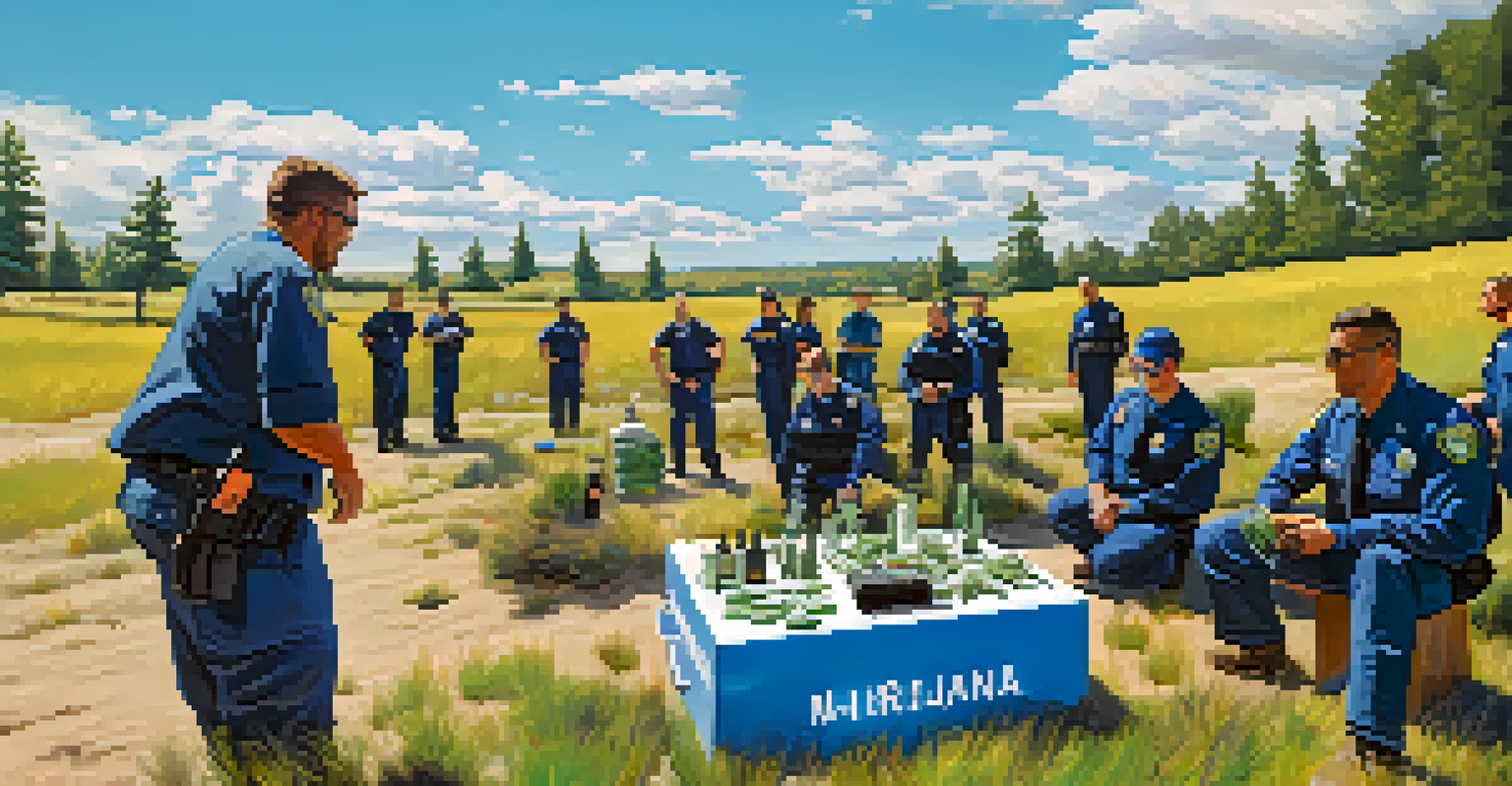Crisis Preparedness: Addressing Marijuana in Disaster Plans

Understanding the Role of Marijuana in Emergencies
In recent years, marijuana has gained legal status in various states, which is why it’s crucial to consider its role during emergencies. With many individuals relying on marijuana for medical purposes, neglecting it in disaster plans could leave vulnerable populations at risk. Understanding how marijuana fits into the broader context of emergency preparedness is essential for adequate planning.
In times of crisis, effective communication can make the difference between chaos and order.
Marijuana may not only serve recreational users but is also a lifeline for those managing chronic pain, anxiety, or other medical conditions. When a disaster strikes, access to essential medications, including marijuana, can be disrupted. This reality emphasizes the need for disaster plans that recognize and accommodate those who depend on it.
Furthermore, the legalization of marijuana has also led to an increase in its use among various demographics. Therefore, having a plan that addresses its availability and use during crises can help ensure public safety and health, making it a crucial component of comprehensive emergency strategies.
Legal Considerations for Marijuana in Disaster Plans
When developing disaster plans, understanding the legal landscape surrounding marijuana is vital. Different states have varying laws regarding marijuana use, possession, and distribution, especially during emergencies. This variation can complicate emergency responses and necessitate clear guidelines for first responders and officials.

For example, some states allow the use of marijuana for medical purposes only, while others have legalized recreational use as well. Emergency planners must be aware of these distinctions to create effective and compliant disaster response strategies. In doing so, they can avoid legal complications while ensuring that affected individuals receive the support they need.
Marijuana's Role in Emergencies
Marijuana is vital for many individuals during disasters, necessitating its inclusion in emergency preparedness plans.
By integrating legal considerations into disaster planning, agencies can better prepare for potential conflicts and challenges. This proactive approach not only enhances the effectiveness of response efforts but also fosters trust within the community, knowing that their unique needs are being recognized and addressed.
Communication Strategies for Marijuana Users in Crises
Effective communication is a cornerstone of successful disaster preparedness, especially concerning marijuana users. Clear messaging about what to expect during an emergency can alleviate anxiety and confusion for those who rely on marijuana. Agencies should develop tailored communication strategies that resonate with this demographic.
The best way to predict the future is to create it.
Utilizing various platforms, such as social media, community forums, and local news outlets, can enhance the reach of these messages. Providing information on how to access marijuana during emergencies, including any changes in legal status, is crucial. This proactive communication can help ensure that individuals remain informed and prepared.
Moreover, engaging with local marijuana dispensaries and advocacy groups can amplify these efforts, creating a network of support. By fostering collaboration, agencies can ensure that marijuana users are aware of their rights and resources, ultimately leading to a more informed and resilient community.
Assessing Community Needs Regarding Marijuana Access
Assessing community needs is an essential step in incorporating marijuana into disaster plans. Communities vary widely in their demographics and reliance on marijuana, so understanding these nuances is key. Surveys and community meetings can provide valuable insight into how residents use marijuana and what they need during emergencies.
By gathering data on the number of medical marijuana users and their specific requirements, planners can create more effective strategies. This may include ensuring access to dispensaries or establishing distribution points for medical marijuana during a disaster. Listening to the community helps build stronger, more inclusive plans.
Legal Aspects of Marijuana Planning
Understanding varying state laws on marijuana use is crucial for developing compliant and effective disaster response strategies.
Additionally, assessing community needs fosters a sense of involvement and ownership. When residents feel their voices are heard, they are more likely to support and engage with disaster preparedness initiatives, leading to better overall outcomes during crises.
Training First Responders on Marijuana Issues
Training first responders on marijuana-related issues is crucial for effective emergency management. As marijuana use becomes more prevalent, responders must be equipped with knowledge about its medical and legal implications. This training ensures that they can support individuals who rely on marijuana during emergencies without exacerbating the situation.
For instance, first responders should be aware of the signs of marijuana use and its potential effects. This knowledge can help them assess situations more accurately and respond appropriately. Furthermore, understanding the legal framework surrounding marijuana can prevent misunderstandings and promote smoother interactions with the community.
By investing in training, agencies not only enhance their preparedness but also build trust with the communities they serve. First responders who are knowledgeable about marijuana can offer compassionate care, which is essential in high-stress situations.
Developing Partnerships with Marijuana Dispensaries
Building partnerships with local marijuana dispensaries can significantly enhance disaster preparedness efforts. Dispensaries play a crucial role in providing access to marijuana for both recreational and medical users, making their involvement in planning vital. Collaborative efforts can streamline resource distribution during emergencies.
For example, dispensaries can assist in creating emergency supply kits that include essential marijuana products. By working together, disaster planners and dispensary owners can ensure that those in need have access to their medications during crises. This collaboration also helps clarify legal responsibilities and operational protocols.
Engaging Community for Better Plans
Assessing community needs and involving residents ensures that disaster plans for marijuana access are effective and inclusive.
Additionally, fostering these partnerships can create a network of support that extends beyond immediate emergencies. Dispensaries can provide valuable feedback on community needs, helping to shape more effective disaster plans in the long run.
Monitoring and Evaluating Marijuana in Crisis Plans
Monitoring and evaluating the integration of marijuana into disaster plans is essential for continuous improvement. After each emergency, agencies should assess how well their strategies worked regarding marijuana access and use. This evaluation process fosters accountability and encourages adaptation in future plans.
Collecting feedback from community members and first responders can provide insights into what worked and what didn’t. Understanding the effectiveness of communication strategies, resource distribution, and overall support can highlight areas for enhancement. This iterative process will lead to more resilient and responsive disaster plans.

Additionally, sharing these findings with the broader community can promote transparency and trust. When residents see that their feedback leads to tangible changes, they are more likely to engage with disaster preparedness initiatives, ensuring that the plans remain relevant and effective.